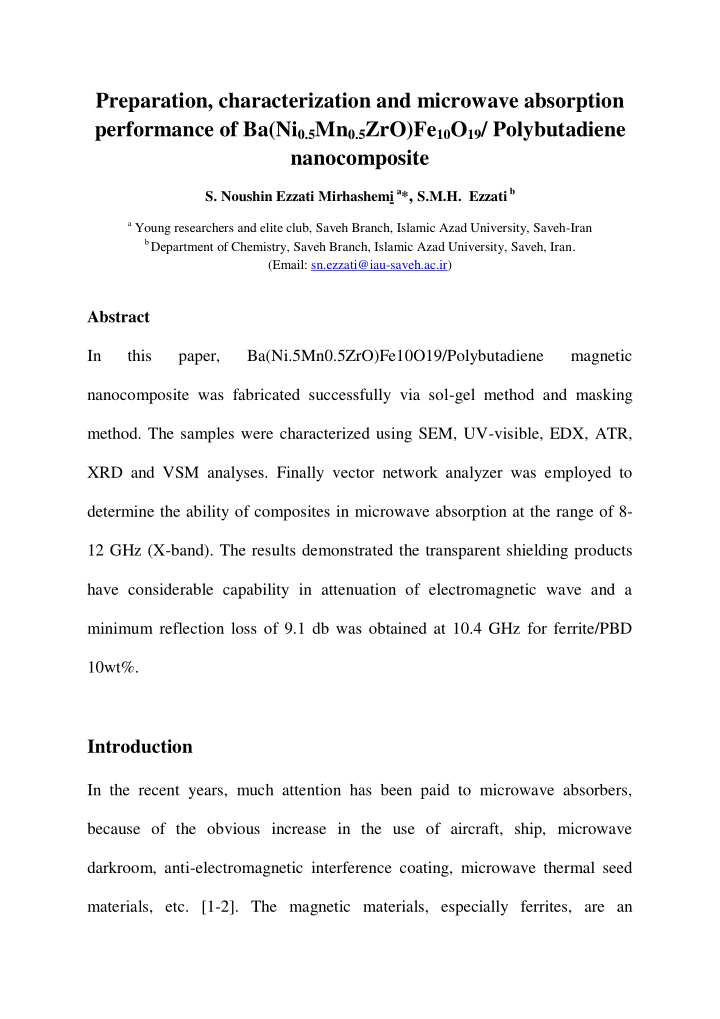



Preparation, characterization and microwave absorption performance of Ba(Ni 0.5 Mn 0.5 ZrO)Fe 10 O 19 / Polybutadiene nanocomposite S. Noushin Ezzati Mirhashemi a * , S.M.H. Ezzati b a Young researchers and elite club, Saveh Branch, Islamic Azad University, Saveh-Iran b Department of Chemistry, Saveh Branch, Islamic Azad University, Saveh, Iran . (Email: sn.ezzati@iau-saveh.ac.ir) Abstract In this paper, Ba(Ni.5Mn0.5ZrO)Fe10O19/Polybutadiene magnetic nanocomposite was fabricated successfully via sol-gel method and masking method. The samples were characterized using SEM, UV-visible, EDX, ATR, XRD and VSM analyses. Finally vector network analyzer was employed to determine the ability of composites in microwave absorption at the range of 8- 12 GHz (X-band). The results demonstrated the transparent shielding products have considerable capability in attenuation of electromagnetic wave and a minimum reflection loss of 9.1 db was obtained at 10.4 GHz for ferrite/PBD 10wt%. Introduction In the recent years, much attention has been paid to microwave absorbers, because of the obvious increase in the use of aircraft, ship, microwave darkroom, anti-electromagnetic interference coating, microwave thermal seed materials, etc. [1-2]. The magnetic materials, especially ferrites, are an
important class of electromagnetic waves absorbers especially, at the range of gigahertz (GHz) frequency. The hexagonal ferrites have high saturation magnetization, large anisotropy field, and the spinel ferrites have strong anisotropy and moderate saturation magnetization at room temperature. They both have good mechanical, chemical stability, and high microwave magnetic loss [3,4]. Conventional absorptive materials such as metal powders and ferrites are high in density and have poor environmental stability, which restricts their usefulness in applications requiring light- weight mass [5]. One way to overcome these problems is to use a suspending agent, which could enwrap magnetic nanocparticles and the PBD provides both electrostatic and steric repulsion against particle aggregation. Also fabrication of flexible and transparent shielding structures could widen the range of applications. In this study, we developed the transparent, microwave absorbent materials based on polybutadiene (PBD), using M-type ferrite. The products were synthesized using one-step sol-gel and masking method. Then magnetic properties and microwave absorption characteristics were investigated. Experimental Ba(Ni0.5Mn0.5ZrO)Fe10O19 nanoparticles were fabricated by sol-gel method, using polymethylmethacrylate (PMMA) as template. First stoichiometric amounts of Fe(NO3).9H2O, Zr(NO3), Ba(NO3), Ni(NO3)2, Mn(NO3)2 were
dissolved in deionized water. Subsequently, citric acid was added to the mixture solution and the pH value of solution was controlled to approximate 7. Then PMMA was added into the precursor sol. The gel formed at 110°C. The gel directly calcinated at 850°C for 1 hour. The next step, PBD coated on Ba(Ni0.5Mn0.5ZrO)Fe10O19 nanocomposites was prepared by ultrasonic irradiation. The certain amount of Ferrite nanocomposites were dispersed in solution of dissolved PBD in THF by ultrasonic treatment and mechanical stirrer subsequently for about 1 hour. The suspension was poured on the glass plates (10cm×10cm) and dried after 24 hours in ambient temperature. Results and discussion SEM was used to determine the morphology and distribution of Ferrite nanoparticles. The SEM image of Ba(Ni 0.5 Mn 0.5 ZrO)Fe 10 O 19 nanoparticles is presented in figures 1a . Due to magnetic behavior of nanoparticles they show agglomerated morphology. The XRD pattern of ferrite nanoparticles is presented in figure 1b. All the characteristic peaks of hexagonal-type lattice are shown in figure which matches with the standard XRD pattern of M-type ferrite (Powder Diffraction File, JCPDS No: 27 – 1029). No extra reflections were obtained. The average particle size of prepared sample was estimated 47.3 nm using Debye-Scherrer formula .
Fig 1. SEM image and XRD pattern of Ferrite nanoparticles The magnetization (M) versus the applied magnetic field (H) for Ferrite nanoparticles were investigated using IRI-Kashan vibrating sample magnetometer (VSM) (Research Institute NanoTechnology of Kashan, Iran) with a maximum magnetic field of 10 kOe. The coercivity, Hc of Ba(Ni 0.5 Mn 0.5 ZrO)Fe 10 O 19 nanoparticles calculated 4529 Oe. Saturation magnetization (Ms) is about 43 emu/g . Also obtained data showed that Ferrite nanoparticles have ferromagnetic behavior . Fig.2. Reflection loss as a function of frequency for PBD/ferrite 10wt% nanocomposite
Figure 2, shows the variation of reflection loss versus frequency determined from Ferrite/PBD nanocomposite. The results demonstrated the transparent shielding products have considerable capability in attenuation of electromagnetic wave and a minimum reflection loss of 9.1 db was obtained at 10.4 GHz for ferrite/PBD 10wt% for the thickness of 5mm. Conclusion In this study for suspending Ferrite nanoparticles, PBD was used as bounding agent. Polybudadiene provided both electrostatic and steric repulsion against particle aggregation. Also the mentioned polymer provides transparent and flexible nanocomposite which widen the range of applications. The composite was prepared using sol-gel and physical mixing method (masking). The samples exhibited good magnetic behavior which goes along with increasing microwave absorption properties and a minimum reflection loss of 9.1 db was obtained for PBD/Ferrite 10wt% at 10.4GHz. References 1. Chang, S., Kangning, S., Pengfei, C., J Magn Magn Mater , 324(2012)802- 805.
2. Tadjarodi, A., Rahimi, R., Imani, M., Kerdari H., Rabbani, M., J. Alloy Comp ., 542(2012)43-5. 3. Tadjarodi, Kerdari H., R., Imani, J. Alloy Comp. , 554 (2013) 284 – 292. 5. Pan, X.F., Qiu, J.X., Gu, M.Y ., J. Mater. Sci . 2007, 42, 2086. 6. Tantawy, R., Aston, D.E., Smith, J., ACS Appl. Matter Interfaces , 5(2013) 4648−4658 .
Recommend
More recommend